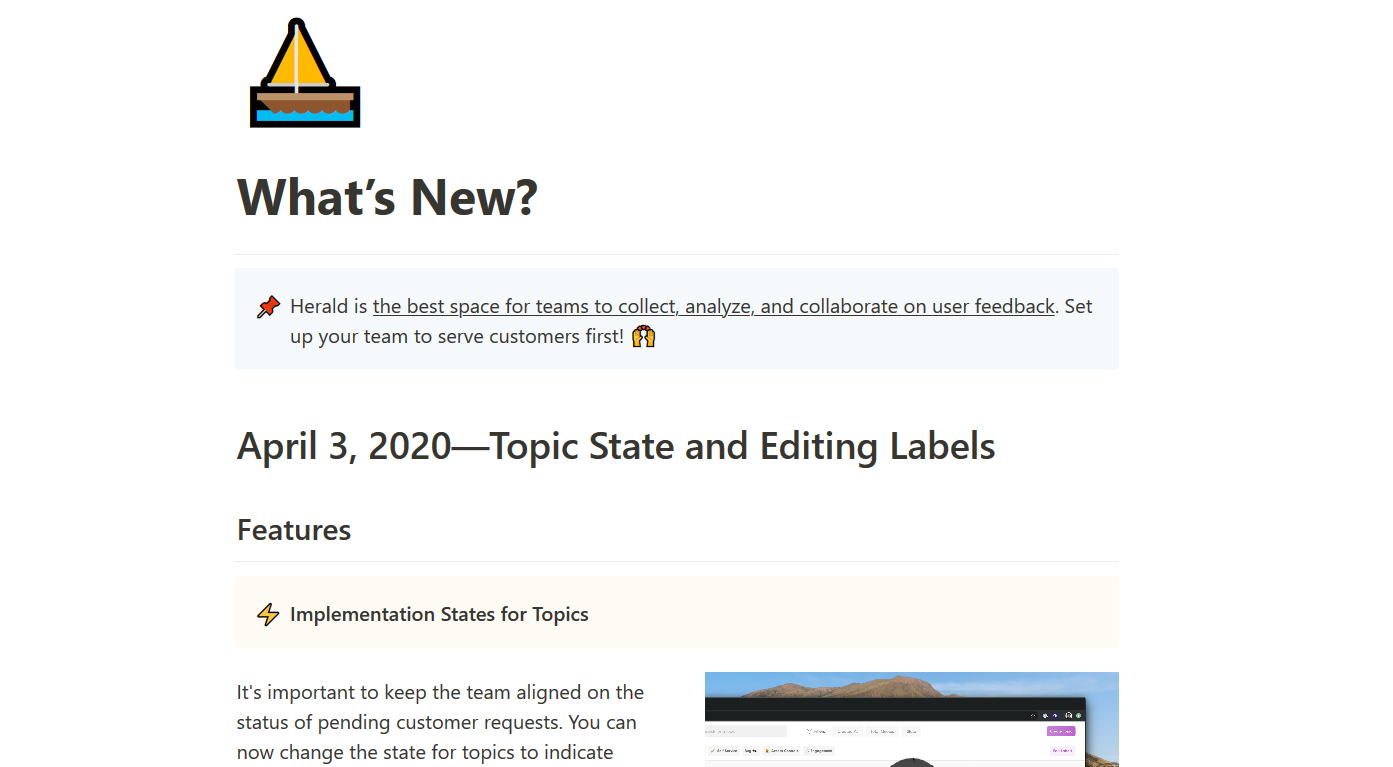Neel and I started working on Herald in December 2019. It’s the best space for teams to collect, analyze, and collaborate on user feedback. Working feverishly over the winter break, we got the MVP in the hands of our first customer in on January 2nd. From then on, we’ve maintained a weekly changelog.

As you may notice, our changelog is nothing fancy - just a simple Notion document. We also follow a simple format for each update:
- Date of update (always a Friday so far) along with a brief theme of the weekly changes.
- Details on the top 2-3 changes alongside a video/photo artifact exhibiting the change.
- A “Bug Fixes & Other Improvements” section with less important changes. We aim to provide details succinctly here.
Every two weeks, we also roll up the changes for the past two updates and send out an email to our users.
As you can imagine, producing the changelog is a fairly taxing task: planning and completing the work, and producing the copy and any associated artifacts demonstrating usage. Given that as a super early stage startup, we’re frequently stretched thin, we often wondered does it make sense to maintain this changelog? This was especially a big question early on, when we only had one customer and it could’ve been far easier to just show them any changes.
Cost of Changelogs
Maintaining a changelog mostly required us to agree to a regular cadence. Otherwise, it would’ve been too easy to skip it “just this once”. As such, we picked a weekly cadence – which forces us to ship some user-facing changes every week. This requirement can actually be a major downside when the right thing to do is to hunker down and solve a larger customer problem. Worse, maybe the best thing that week may not even be feature development but an infrastructure change, or maybe even non-product work like sales or marketing. In other words, a weekly changelog basically forces us to do product work every week even if it’s not the best thing for that week.
Disclaimer
A dogmatic publishing cadence is not a requirement for a good changelog. It doesn’t seem like Notion has one.
An alternative to a dedicated changelog is to simply use the company’s blog to write about major product updates whenever they occur. With this approach, there is no need to align to a fixed update cadence providing the flexibility to work on bigger and bolder challenges that may not be shippable in a week.
So, is a dedicated changelog too much work with plenty of rigidity?
Benefits of Changelogs
After maintaining a changelog for the last 3 months, I’d have to say that it’s a large net positive. In fact, we’d love to maintain our weekly changelog for as long as possible. The two primary benefits we’re getting out of our changelog are:
- Accountability: Make sure we ship at least two customer-facing product features every week. As a young startup, we’re glad that our product iterations adhere to a certain product velocity floor.
- Iterate with Customers: A short window to get new features out means that we do not have the luxury to come up with grand plans, execute them, then reveal it to our customers. From our previous experiences (and failures), we’ve learnt that we are suckers for grand plans that don’t pan out. With the current model, we descope feature work to something we can ship in a max of two days. Often, it means shipping half-baked features, but it still seems to be working out for us. When customers engage with the new changes, they often ask us for additional features we had descoped – but now we can work on them knowing fully that it will be a meaningful change. However, just as often, when customers don’t even end up using the new features or ask us for entirely different things than we had imagined, we can course correct at a far lower cost.
It’s still early days for us at Herald, but we are totally loving using the changelog as a mechanism to plan our weekly sprints. You may have noticed that I didn’t even mention that the changelog informs our users about new changes as a benefit— it is just an added bonus and not our primary motivating factor. Our most engaged users check our changelog religiously and provide us earnest feedback, which we obviously save in our dogfood instance of Herald.
An Industry Trend: The Fall and Rise of Changelogs
Historically, changelogs were a given for all software — as software needed to be installed on a customer’s computer. They informed users about the amazing value they’d get if they just upgraded to the newest version of the software. The biggest reason for maintaining changelogs was the revenue that accompanied upgrades. However, with the rise of SaaS and recurring revenue models, the monetary reasons for maintaining a changelog no longer hold. As such, we’ve seen a decline of dedicated changelogs with the rise of SaaS.
However, a new breed of SaaS companies are producing are going back to maintaining a dedicated changelog. Some of my favorites changelogs are: Notion, Linear, Tandem, and OpenPhone. I am always looking to read and learn from good changelogs – let me know if you know of a good one.